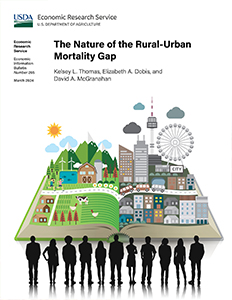The Nature of the Rural-Urban Mortality Gap
- by Kelsey L. Thomas (Conley), Elizabeth A. Dobis and David McGranahan
- 3/5/2024
Overview
The 2019 age-adjusted natural-cause mortality (NCM) rate for the prime working-age population (aged 25–54) was 43 percent higher in rural (nonmetropolitan) areas than in urban (metropolitan) areas. This is a shift from 25 years ago when NCM rates in urban and rural areas were similar for this age group. As a first step to understanding the increasing gap between rural and urban NCM rates, this report examines natural (disease-related) deaths for prime working-age adults in rural and urban areas between 1999 and 2019 using data from the U.S. Department of Health and Human Services, Centers for Disease Control’s Wide-ranging Online Data for Epidemiology Research (WONDER). Prime working-age NCM rates are examined for the population as a whole, as well as by sex, race and ethnicity, region, and State. Overall, both an increase in the rural, prime working-age NCM rates and a decrease in the corresponding urban rates are contributing to the growing mortality gap.
How to Cite:
Thomas, K. L., Dobis, E. A., & McGranahan, D. (2024). The nature of the rural-urban mortality gap (Report No. EIB-265). U.S. Department of Agriculture, Economic Research Service. https://dx.doi.org/10.32747/2024.8321813.ers
Download
-
Entire report
Download PDF -
Report summary
Download PDF

